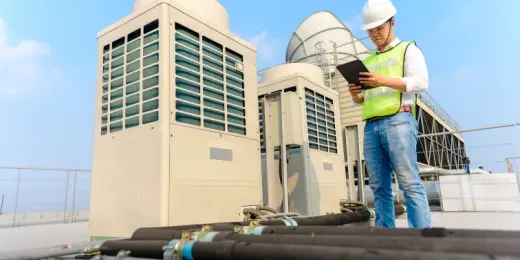What is Building Maintenance?
Building maintenance involves a wide range of tasks aimed at ensuring the functionality and upkeep of a building or facility. It includes cleaning common areas, checking building structural integrity, and maintaining essential functions like electrical systems, heating, and air conditioning systems.
Why is it Important?
Building maintenance is a part of building management process that is crucial for ensuring the safety and overall functionality of a building, as follows:
-
- Health and Safety of Occupants: Proper building maintenance oversees a safe environment for its occupants. Maintenance helps prevent structural issues that can potentially compromise the safety of occupants over time.
- Cost-Effectiveness: Regular maintenance is more cost-effective than emergency repairs, helping to avoid costly bills and ensuring the building is well-maintained. Proactive maintenance helps identify and address minor issues before they escalate into major problems requiring expensive repairs
- Long-term Value : Well-maintained buildings create a positive impression of the building’s appearance through cleaning, painting, and repairs that enhance its overall image and professionalism.
- Regulatory Compliance – Building maintenance often incorporates meeting regulatory standards, such as National Construction Code (NCC) in Australia, that govern the construction, design, and maintenance of buildings.
Tasks and Responsibilities in Building Maintenance Procedures
Building maintenance involves a variety of tasks and responsibilities carried out by different professionals to ensure the functionality, safety, and aesthetics of a building. Here are the key responsibilities for various roles in building maintenance procedures:
General Upkeep
The following jobs fall under the responsibility of janitors:
- Cleaning common areas like floors, bathrooms, and windows.
- Removing trash regularly.
- Washing windows and glass doors
General Maintenance Tasks
Maintenance technicians carry out the following tasks for general maintenance:
- Inspecting, repairing, and maintaining building systems such as HVAC, electrical, and plumbing
- Handling tasks assigned through work orders
- Reporting to supervisors overseeing maintenance activities
Facility Management
Facility managers are in charge of these maintenance activities:
- Developing, implementing, and maintaining maintenance schedules and policies for all building systems and equipment
- Monitoring, repairing, and performing routine maintenance on building facilities and equipment
- Ensuring compliance with safety codes and regulations
- Training, supervising, and assisting maintenance staff
Specialized Tasks
For more targeted maintenance needs, you can employ the help of outsourced vendors:
- Providing specialized services like snow or ice removal, landscaping, pest control, and emergency repairs
- Assisting with specific tasks such as HVAC servicing, plumbing repairs, or electrical work based on contractual agreements
Best Practices
On top of having a building maintenance system, here are some best practices that can help your workers stay effective in maintaining your properties’ best condition :
- Regular Inspections and Preventive Maintenance – Conduct regular building inspections to identify issues early. Implement preventive maintenance measures to address potential problems before they escalate.
- Emergency Response Plan – Develop and maintain an emergency response plan to handle unexpected issues efficiently. Adequately stock inventory and train an emergency response team to minimize downtime and disruptions.
- Sustainable Maintenance Practices – Focus on sustainable practices like optimizing energy consumption and eco-friendly waste management. Incorporate sustainable strategies into maintenance routines to cater to eco-conscious occupants and property owners. This may involve strict policies regarding waste in the premises and other practices to avoid unnecessary consumption of resources.
- Continuous Improvement – Collect feedback on maintenance practices and strive for continuous improvement. Invest in training and development to keep maintenance teams updated with the latest trends and practices.
- Compliance with Regulations – Stay updated on building codes, safety standards, and environmental regulations. Ensure compliance with local codes and regulations to avoid penalties and legal issues.
Frequently Asked Questions about Building Maintenance
Maintenance tasks should be performed on a regular schedule, but each tasks will have a different frequency:
- Daily: Cleaning common areas and checking for hazards.
- Weekly: Cleaning floors, testing alarms, and checking HVAC filters.
- Monthly: Inspecting plumbing and conducting pest control.
- Quarterly: Servicing elevators, testing generators, and inspecting sprinkler systems.
- Annually: Inspecting structural elements, servicing fire suppression systems, and updating emergency plans.
Adjustments may be needed based on the building’s age, usage, and specific systems. Regular inspections help identify issues early and prevent costly repairs.
Hiring in-house maintenance staff or outsourced maintenance services mostly differs with budget, specialties, and response time. In-house maintenance staff are often more expensive (salaries, benefits, and equipment), whereas outsourced services are often more skilled, flexible, and more affordable. However, outsourced services may not be reliable especially for urgent and emergency repairs. Having the least familiarity with the building’s structure may add more time it takes for them to perform tasks compared to in-house staff. Some buildings may benefit from a combination of both approaches, utilizing in-house staff for routine maintenance and outsourcing specialized services as needed.




